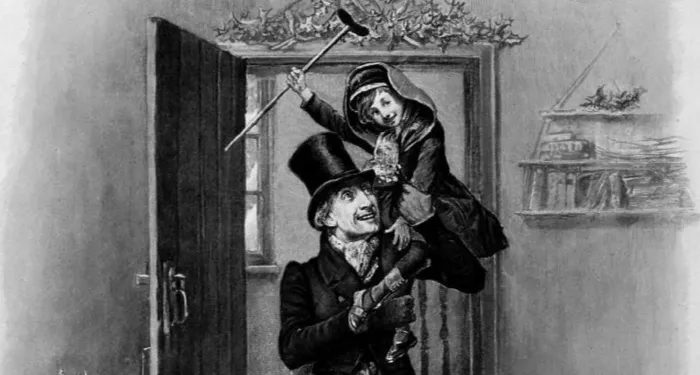
Tiny Tim: Complex Reactions to a Stereotypical Character
Content Note: ableist language in context
Charles Dickens’s classic novella A Christmas Carol has been adapted countless times. Because this is Ebenezer Scrooge’s conversion narrative, all of the other characters are static, not dynamic. Bob Cratchit’s youngest son, Tiny Tim, is an idealized but pitiable stereotype of disabled people. He contributes to the idea that disabled and poor people deserve pity and charity.
Dickens’s books are full of social critique and scenes of abusive institutions. Before his conversion, Scrooge jokes that these tax-funded institutions should be sufficient to help poor and marginalized people. The Ghost of Christmas Present later shows him why they are gravely serious, and nowhere near sufficient. By the end of the story, Scrooge is still rich, but gives generously to charitable funds and to the Cratchits. Individual generosity must supplement the basics that the government provides, the story suggests.
As a child, my favorite adaptations of A Christmas Carol were The Muppet Christmas Carol and local theater productions. As a disabled child seeing one of my first disabled characters ever, my thoughts on Tiny Tim were complicated. In 2018, I wrote on Book Riot: “At one extreme, characters like Tiny Tim are objects of pity, whose disabilities make them seem saintlike.” Tiny Tim’s disability is not specified, but he walks with a crutch and looks frail in most productions and illustrations. Without access to good nutrition and medical care, his death is imminent. In other words, poverty will kill him, while donations could save his life. In terms of character development, Tiny Tim is only slightly better than the starving children named Ignorance and Want who hide under the Ghost of Christmas Present’s robe. They all exist to be pitied and helped—their only function in the story.
In 2018, Derek Newman-Stille wrote: “The trope that I call the ‘Tiny Tim’ is the creation by an author of a disabled character whose exclusive role is to be an object of pity and in need of charity…Tiny Tim doesn’t have a life outside of his role as an object of pity, and his entire existence is about teaching an able-bodied man to be more charitable and share his wealth.” I agree that Tim is almost a one-dimensional character. He has no character flaws. Disability is not a flaw. He contributes to stereotypes of saintly, tragically suffering disabled people.
I did relate to some aspects of Tiny Tim’s character. “Somehow he gets thoughtful, sitting by himself so much, and thinks the strangest things you ever heard. He told me, coming home, that he hoped the people saw him in the church, because he was a cripple, and it might be pleasant to them to remember upon Christmas day who made lame beggars walk, and blind men see.” (This passage from the book is quoted verbatim in the 1984 TV movie starring George C. Scott.) This historic language is considered ableist today. Although I never wanted a cure, I did relate to Tim’s introspection, spending a lot of time alone as a disabled child. I also looked for people like me in stories like A Christmas Carol and religious stories of miracle cures. This passage also contributes to the stereotype of disabled children as special or gifted, often in a spiritual or religious way.
Also in the 1984 version, Bob Cratchit says something to Tim like: “You’ll be there one day, running and laughing with the other children.” This promotes an idea of overcoming disability. I related to the idea that I might get stronger with exercise. However, I knew that I’d always be disabled and that having the range of motion of a non-disabled person wasn’t a realistic goal. Some disabled people want cures and some don’t. However, the Tiny Tim stereotype assumes that we all necessarily want to be cured. It also conflates disability with helplessness and tragedy.
In the Christmas future where Tim dies, Bob Cratchit gives a heartbreaking speech about loss. His grief is relatable, but as a typical Victorian character, he explicitly moralizes Tim’s death and disability: “I know, my dears, that when we recollect how patient and how mild he was; although he was a little, little child, we shall not quarrel easily among ourselves, and forget poor Tiny Tim in doing it.” To me, it always felt manipulative for Bob to guilt his surviving children out of arguing by invoking their dead brother’s innocence and disability.
Disability representation has moved far beyond Tiny Tim, but some organizations still try to use disabled people to tug at donors’ heartstrings and elicit pity and donations. Disabled activists frequently criticize telethons, other charities, and news media for objectifying disabled people.
Pop culture still frequently parodies Tiny Tim. In Shrek, the Gingerbread Man quotes Tiny Tim’s famous saying: “God bless us, everyone,” after the gingerbread cookie loses his legs. Even today, ableist jokes and memes about Tiny Tim are common. Although Tim Cratchit is a fictional child written almost 200 years ago, many depictions of disabled people still paint us as permanently childlike and idealized. Ableist tropes wrongly suggest that disabled people exist to inspire, or serve as a contrast to, non-disabled people.
Read More
6 A CHRISTMAS CAROL Retellings Reimagining the Classic Ghost Story












